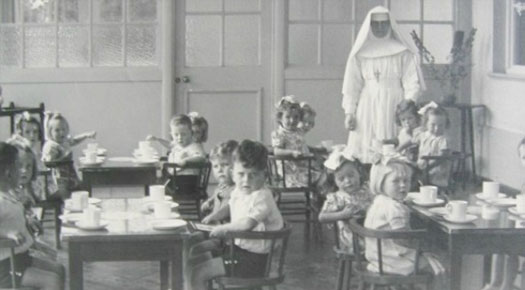
The Catholic Church in Ireland is under fire after a researcher discovered hundreds of dead bodies of babies in the septic tank of a former home for unwed mothers. Researcher Catherine Corless found that children died frequently of various diseases during the 35 years that the home operated from 1926 to 1961. Reportedly, the bodies were secretly disposed in what was once a septic tank, with simple shrouds and no coffins. No memorials were erected for the dead children and their graves were left unmarked.

“When I was doing the research, someone mentioned there was a graveyard there for babies but I found out there was more to it than that,” said Corless.
According to a 1944 government inspection, 271 children at the Tuam orphanage suffered from malnutrition, often dying because of sickness, neglect, deformities, convulsions and contagious diseases like tuberculosis, measles, pneumonia as well as premature births. Corless said that 12-year-olds Barry Sweeney and Francis Hopkins discovered the burial site in 1975 and after a priest blessed the area, some locals decided to groom the place and build a grotto in respect for the dead.

Church leaders in Galway have said they were clueless that so many children who died at the orphanage had been disposed in the septic tank. They have pledged to support local efforts to mark the spot with a plaque listing all 796 names that were found in the child death records recovered from the home run by Catholic nuns. However, investigators fear more than 800 bodies could have been disposed. Corless has formed a group called Children’s Home Graveyard Committee who wish to take charge of erecting the memorial. Archbishop of Tuam Michael Neary said he would meet with Bon Secours Sisters, the organization of the nuns who ran the home, to raise funds for the plaque.
This particular home in Tuam was one of the many Catholic and Protestant establishments set up for “fallen women” across Ireland, which had astonishingly high infant mortality rates. Those who survived were called the Home Babies and often ostracized in Irish society until they were adopted out by foreigners.

The former home was brought down a few decades ago to make space for a housing estate but a missing persons’ report filed recently means that the burial site may now be excavated. A relative of William Joseph Dolan, who failed to find a death certificate for the young boy despite him dying at the orphanage, filed the complaint.
“I just want to know what happened to him. He may have passed on, yet there is no death certificate. I believe he might have been fostered out and then moved to the US… He could still be alive or he's in the grave. I want to find out,” said the relative who requested to remain anonymous.
Teresa Kelly, chairman of the Children’s Home Graveyard Committee, said the excavation has been long overdue.
“It's an awful story… It's a mass grave. Many of the babies were malnourished. We want to make sure those children's identities are acknowledged. They had names, they were human beings, not animals,” she said.
Since the burial site was discovered recently, people from across the world have been using Twitter to press for an investigation into the Tuam deaths via online petitions and hashtags like #HomeBabies and #800DeadBabies.
Post by Dave Muscato.
Photo Credit: The Old Tuam Society
